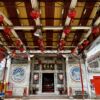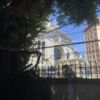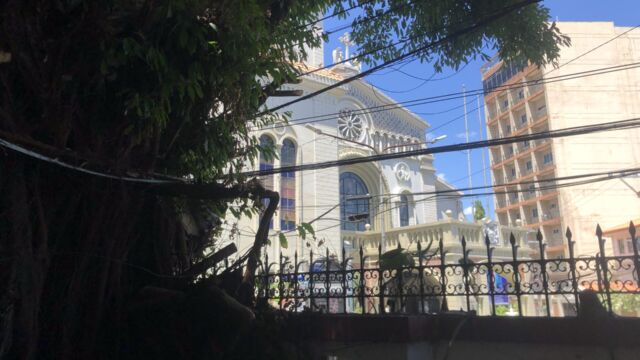Disappearances and Reappearances
Earnshaw Street | 2,424 words
Turning onto Earnshaw Street, I sharpen my gaze in search of something familiar. For blocks, all the building exteriors are as gray and flat as the road itself. Unlike other streets in Sampaloc, a district in an area known as Manila’s university belt, this one has no remarkable institutions. Some of the nation’s cornerstone universities are housed on parallel roads, but there are no particularly memorable landmarks on Earnshaw itself.
Some locals would disagree. They might mention the health center, the big bank, or the Chinese chicken restaurant. Most would likely note that on the south end of the street stands an urban anomaly: two Catholic churches planted side by side. Saint Anthony Shrine and Our Lady of Loreto have been around long enough to be nicknamed “Mister and Missus” by those in the know. But perhaps because I’m not one to pay attention to religious architecture, or because the construction boom of the past few decades has muted the pair’s stature as an undeniable landmark, I find these churches rather invisible. Were I to give directions to the exact spot where I’m standing — just within the shade of a mango tree that obscures the facades but not the crucifixes of the twin temples — I’d tell my visitor to look for the golden arches of the McDonald’s next door.
Of course nothing is truly invisible on a Manila street. From the pedestrians fighting for every sliver of sidewalk, to the proliferation of elevated highways blocking entire swathes of sky, the city can be accused of horror vacui — the Aristotelian idea that empty space is abhorrent. Yet, belligerently busy, our clutter culture ensures a Where’s Waldo way of life. And as anyone who has ever walked straight past their rideshare or waved to a friend only to be ignored knows, anything can disappear on a city street.
Entire streets can risk escaping consciousness, too. Lined with provincial bus depots that serve the full island of Luzon, from Legazpi to Laoag, everything on Earnshaw seems to capitalize on transience. Nondescript traveler dormitories, myriad money transfer kiosks, cash machines, pawnshops, fast food outlets, and beds-by-the-hour — the main reason people come to this street is to get right off it.
But for me, this is the destination. On the corner of Earnshaw and San Anton, hidden under a layer of grime and behind a pyramid of oranges on a mobile fruit stand, is a brass plaque commemorating Edgar Mirasol Jopson: scholar, revolutionary, and martyr of Ferdinand Marcos Sr.’s decades-long regime. He was also my uncle.
Edjop, as he was known, was a student and labor rights activist who came into the public eye during the First Quarter Storm of 1970 — a historical movement that erupted in the streets of Manila, when youth and community leaders mobilized droves, sometimes up to 100,000 at a time, to protest the flagrant corruption and erosion of democracy under the first Marcos regime. The movement was followed by a swift and merciless reaction from the nation’s strongman who, after leaving protesters tear-gassed, beaten, and shot on the thoroughfares surrounding Earnshaw, subsequently suspended habeas corpus, unfurled the banner of Martial Law, and ushered in an enduring dictatorship rife with human rights abuses.
It was during the initial days of the First Quarter Storm that 21-year-old Edjop met with Marcos at Malacañan Palace, just a stone’s throw from this fruit stand. In the televised exchange, the student asked the president to put into writing his claim that he would not stay in office beyond the end of his term. Marcos infamously snapped: “Who are you to tell me what to do! You’re only a son of a grocer.” The epithet echoed through the airwaves, not as the insult it was hurled as, but as a declaration of membership to a fraternity of frustrated Filipinos. Who are you to tell me what to do. Many found themselves answering back in solidarity: we are the people, and the government works for us.
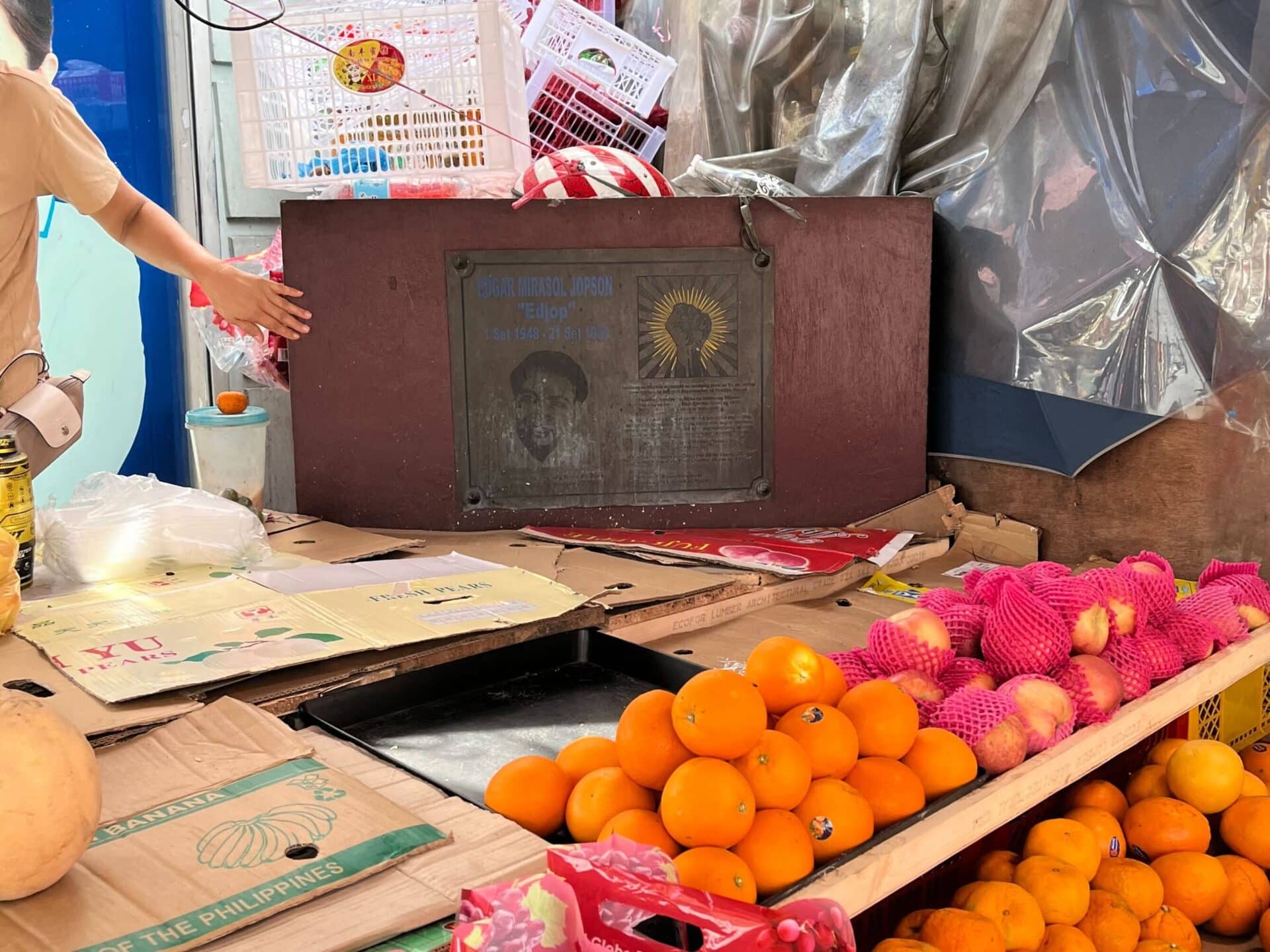
Twelve years later, an unarmed Edjop, by then a member of the Communist Party, would be summarily gunned down by Marcos’s secret police as a matter, supposedly, of national defense.
The Earnshaw marker commemorating Edjop now stands in front of where my family’s grocery once did. Opening in 1958, Jopson Supermarket was one of the first full-service stores in the Philippines. It stayed in that spot for a quarter of a century before expanding to a larger space across the street. Today, the original four-story building has been subdivided into a pharmacy, eye clinic, and minimart on the ground level, as well as a pool hall and dormitel on the upper floors. The expansion on the other side of the road remains a grocery, but under new owners and a different name.
I was a year old when the business shuttered in 1987, which is to say I am the youngest person in the Jopson clan to have been alive during its existence. And I haven’t been back since. As such, I have no fully formed memories of the place. There are a few fragments that have stayed with me though. Wide aisles. Sun shining hotly over the entryway. Someone toting me on their hip as my Kuya and Diko play on the sidewalk out front. These images have always felt more constructed than remembered. But when I walk into the store again now, I know they’re real.
No longer a resident of Metro Manila, I had to purchase plane tickets to go on this Earnshaw excursion. I told Tita Marie and Tito Plops, my gracious guides today, that I’m trying to connect with an important part of our family’s history. And so, complementing a narrated tour through Padre Burgos Avenue, where they witnessed the 1970 protests first-hand as teenagers, and España Boulevard, where they joined the marches themselves, my tita and tito have cordially led me from the bus station at the corner of Lacson and Earnshaw all the way down to this pyramid of oranges. Tita Marie chats with the fruit stand vendor about the importance of remembering, while Tito Plops takes out a towel to wipe the grime off Edjop’s face. Knowing how quickly history can be revised, I feel lucky to be among these oranges, witnessing the sundry ways one can pay tribute to the truth. So I’m not sure what’s pulling me away.
I cross Earnshaw from Edjop’s plaque to the grocery’s second location. It’s a cloudless day, but the air is gray with a mixture of cigarette haze and the chicken-smoke from an Andok’s kiosk tucked into the current grocery’s storefront. Walking through the fog, I emerge at the front door, where I’m greeted by my silhouette against the glass. I’m the one toting a child on my hip, now.
I’m here to learn about the Jopsons, but, like everyone else who ends up on Earnshaw, I realize at this moment that I’m searching for something more too. I look around: a tricycle driver calls out for passengers, a stray dog sleeps in the shadow of an electrical pole, a stew of old rain and rotting garbage clogs the gutter. May Manila’s mundane mesmerize me. My child points at the door and I walk through.
In these early years of motherhood, I have sublimated my thinking, my movements, my sense of self — willingly and happily, I must add, but fully — into caring for my child. Getting married and pregnant in the panicky pre-vaccine days of the pandemic may have contributed to the internal upheaval. But the desperation feels more ancient. Like many others in this silent sisterhood, I’m in the dark, grasping for a thread back to myself. The beginning seems like the right place to start looking.
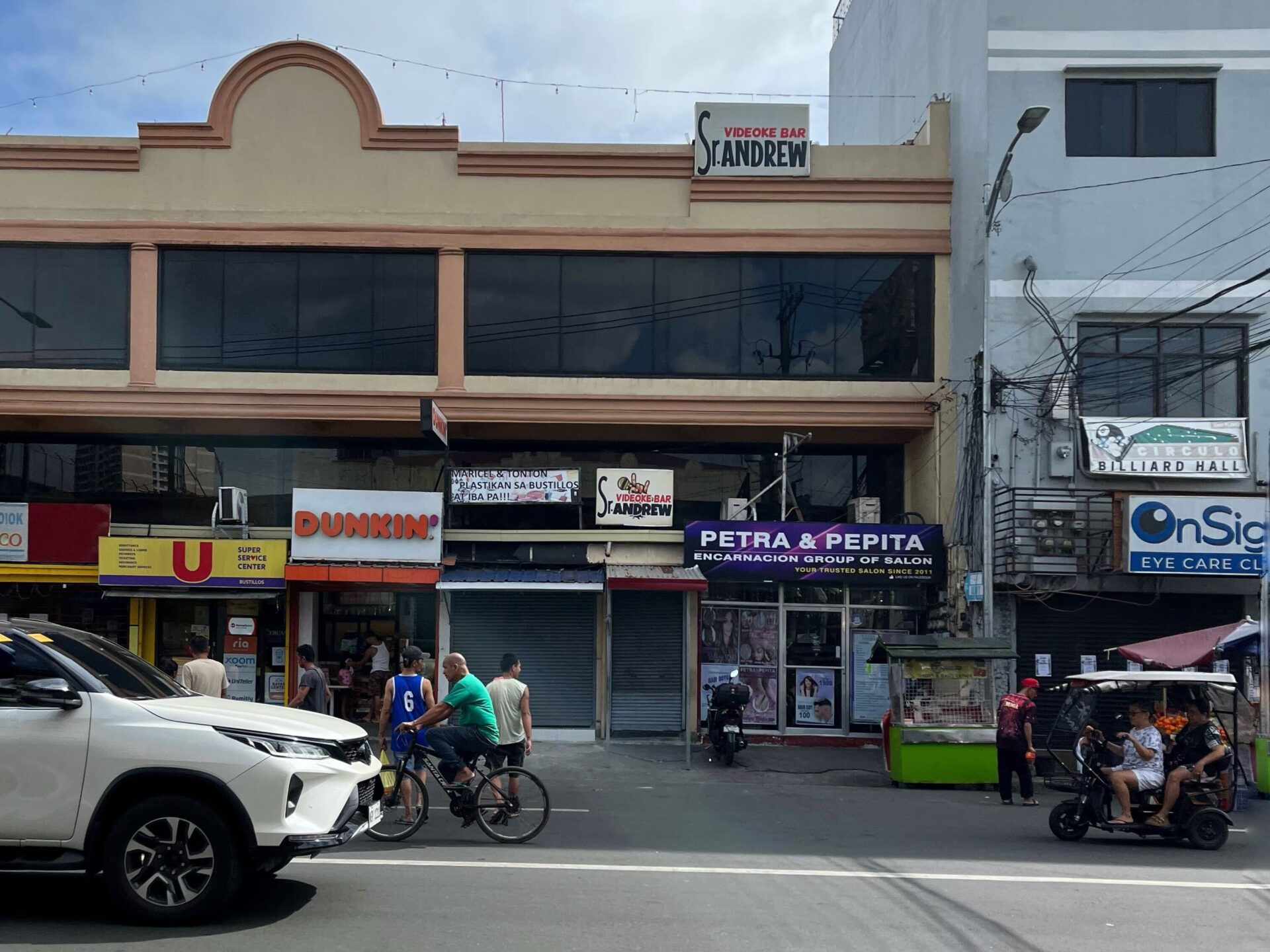
I was born in this very neighborhood, on a cross street of Earnshaw, two and a half blocks from the store. Close to where I’m standing now is where I likely spoke my first words and took my first steps. For a time, this was the only world I knew. And then came departure after disorienting departure. From having lived on four continents before the age of 40, to having shed entire identities with each new stage of parenthood, I have often wondered if I am rooted to anything at all. Coming here is as close as I’ve gotten to an answer.
A coach bus from some faraway province lurches onto the street. I suppose what is beckoning isn’t calling out only to me.
Perhaps it’s the ghost of Manuel Earnshaw drawing us here. The homegrown shipbuilding tycoon inherited a foreign surname from a British father, but he was as Filipino as anyone else who had lived in the country their entire life. Or at least almost his entire life. For four years he was Resident Commissioner — essentially a non-voting member of Congress — in Washington, DC. The Philippines, which had been under US occupation for over a decade when he came into office, was itching for independence. But the colonizers refused, citing that the young country would be neither economically nor politically stable enough to rule itself. Earnshaw, for his success in business, was touted as a symbol of the thriving Philippine economy. Though he had neither interest nor experience in politics, his newfound position, engineered by would-be president Manuel L. Quezon, served as a two-pronged response to America’s doubts. And lo, it was during his tenure in DC that the Jones Act, which ensured Philippine autonomy, was signed into law. It would take another 30 years for the Jones promise to materialize. By then, Earnshaw was long gone. He shot himself while inside his family’s crypt in Manila North Cemetery. Without children, the name would have died with him in the mausoleum. But it lived on in history books. And at this address.
Earnshaw the man existed in abundance. Yet his riches, reputation, and role in changing history couldn’t keep him here. From the store’s entryway, I see the dog rise from her position in the electrical pole’s shadow to sniff out a piece of chicken that has dropped on the sidewalk. Carrying it in her mouth, she trots out of sight. Manuel Earnshaw’s aptitude for achievement followed by abscondence haunts this place.
My grandfather, Hernan Jopson, established himself here following World War II. A soldier during the Japanese occupation, before supermarkets existed in the country, young Hernan got the idea to disrupt the model of the traditional sari-sari store — a cubicle-sized neighborhood shop where sundry items are sold through a grill- or screen-covered window. Detained in a concentration camp following the Bataan Death March, he saw a picture of a roomy grocery store in the remnants of an American magazine. The following decade, with seed money received from his and my grandmother’s wedding, he welcomed the public into Jopson Supermarket.
It was a hit. He helped usher the nation into its post-war growth and enjoyed the fruits of that era. It’s hard to imagine now, but there was a time when this soot-covered street was one of the more vibrant places in the city. Various establishments sprouted around and, like Jopson Supermarket, thrived for decades. The family-run store did so well that when it moved its new location was quadruple the original space’s size. But in an Earnshawian twist, it remained there just a few short years before my grandfather sold the business.
The sale coincided with other establishments closing up shop as the country transitioned into a new era following the ousting of Marcos in 1986. Some cited the deteriorating buying power of locals for the mass exit of Earnshaw’s long-standing businesses. Undoubtedly, decades of plunder eroded the Philippine economy — the center of which is the city of Manila. Those who could escape moved abroad or further inland to quieter developments in Quezon City and Pasig. Jopson Supermarket was not immune to the seachange. The years that saw shoppers checking out pushcarts full of groceries gave way to a new season of shoppers barely filling handbaskets.
These days, the existing store caters to the eclectic needs of budget-conscious customers. The sprawling space peddles everything from underwear to dining tables on the ground level, to faux-jade dragon sculptures on the upper floor. The aisles look as they do in my memory, wide and bright. I’m delighted by the fever-dream organization of the inventory, how it underscores the surrealness of this visit. Sardines stacked next to toilet paper. Fabric softener next to bread. More than a grocery, it’s a metonymy for Manila: meticulously planned at the outset, it has descended into unsettling, though at times endearing, disorder.
On the other side of the cash registers, the hypnotic mish-mash of commercial offerings intensifies. First, there’s the traditional fare. Row after row of bargain cellphone cases punctuated with low-quality speakers blasting, at display-shaking volume, Maroon 5’s worst songs. Two or three customers are singing along, almost against their will. I am one of them. The six makeshift karaoke stalls buzzing along the north wall, the riot of neon arcade games dinging and pinging for no one, another horror vacui, this one for hearing, echoing the city’s clamor – all of it predictable, prosaic, hardly perceptible.
Then, carved into the cacophony: areas of attempted zen. Four deep-massage chairs wedged between slot machines and an air-hockey table. A marble-esque water fountain bubbling next to an industrial fan. The Buddha statues alongside a mechanical Captain America.
My toddler gets excited and yells, “Spider-Man!” I, too, am confused about what I’m looking at.
But I’m looking.
Maybe Earnshaw’s gift is in its dualities. Here, things come in diametric pairs. Chaos and calm. Fabric softener and bread. Saint Anthony and Our Lady. The ghost of Jopson Supermarket’s heyday facing the ghost of its demise. Here, contrasts co-exist. This is a place of arrival and departure. Where Edjop, heir to the enterprise, learned the value of labor, eventually encouraging the grocery workers to unionize. It’s also where, after his death, that same union staged the ultimately unlawful but still devastating strike that drove Jopson Supermarket to extinction.
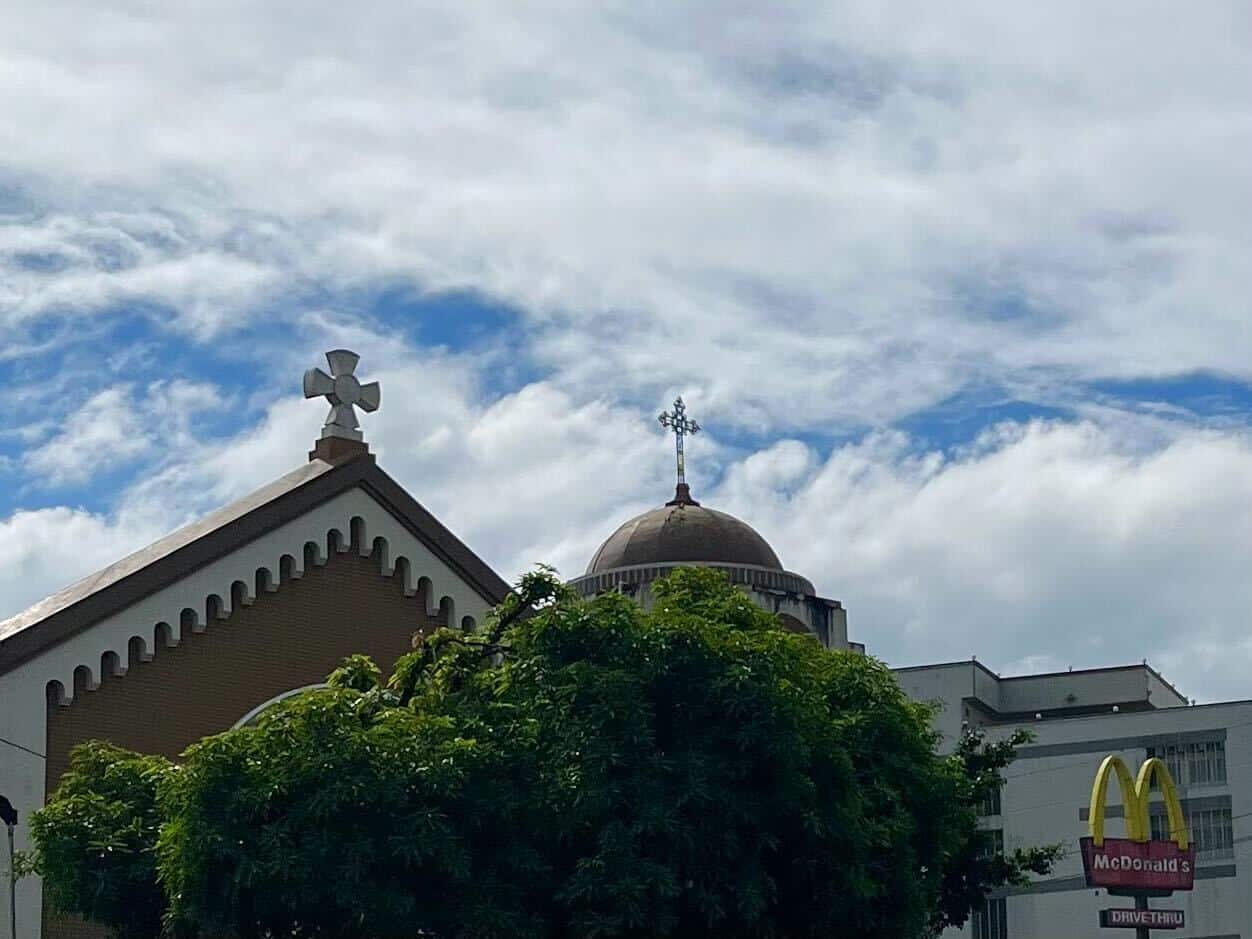
Papered from the inside with yellowing newsprint, the windowpane of an empty shop at the building’s portico reflects the street with striking clarity. Earnshaw is a place of ambition and abandonment. It reveals Manila by disappearing into it. I’m old glass myself. That this is where my life began makes me no less prone to becoming invisible right where I stand.
My husband snaps a photo of me in the middle of it all. He flips the phone in my direction so that I can see. I adjust the baby on my hip as I lean in. There I am.
© Pauline Arnould
Commissioning editor: Glenn Diaz
Q&A with Pauline Arnould

-custom_crop.jpg)
